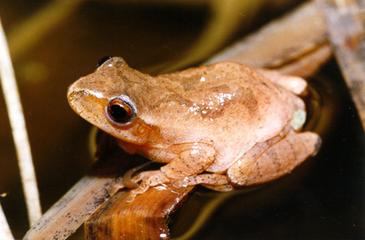Adaptation
In the transition from water to land amphibians are the middle man, and they utilize both environments. What are some ways Spring Peepers have adapted to their environment?
Hibernation
 During
the winter months spring peepers curl up under the soil, piles
of leaves, rotting trees or under rocks for hibernation. Spring
peepers can withstand extremely cold conditions; they can
actually survive being completely frozen for up to three days. The key to their survival is the production of large amounts of
glucose from their livers, it acts as an anti-freeze in their
blood. This also limits dehydration and prevents cell damage.
Since they are also one of the first frogs to come out of
hibernation, they rely on their fat reserves for awhile until
their food source comes back.
During
the winter months spring peepers curl up under the soil, piles
of leaves, rotting trees or under rocks for hibernation. Spring
peepers can withstand extremely cold conditions; they can
actually survive being completely frozen for up to three days. The key to their survival is the production of large amounts of
glucose from their livers, it acts as an anti-freeze in their
blood. This also limits dehydration and prevents cell damage.
Since they are also one of the first frogs to come out of
hibernation, they rely on their fat reserves for awhile until
their food source comes back.
Other Adaptations:
-
Spring peepers are nocturnal animals, mostly so they can hide from their predators during they day and feed at night.
-
They also have toe pads for climbing and grabbing on plants.
-
The spring peeper has gray and brown skin which camouflages it from predators.

-
It can also jump extremely high to catch its prey, flying insects.
-
They also bury themselves in mud or deep water during extreme heat. This is called estivation.